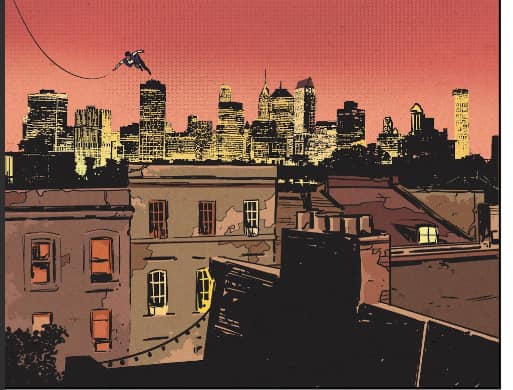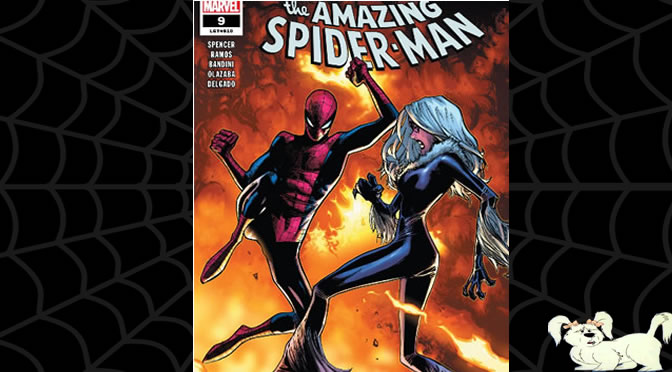 The actual title for this is Generations: Miles Morales: Spider-Man and Peter Parker: Spider-Man but that just does not sound as good as The Spiders. This is also my finale for the story that sees Miles Morales decide to abandon the moniker of Spider-Man. While we never see him actually take on a new name, I find it hard to believe he will retain the role of Spider-Man through 2018 unless the movie sways things in a new direction.
The actual title for this is Generations: Miles Morales: Spider-Man and Peter Parker: Spider-Man but that just does not sound as good as The Spiders. This is also my finale for the story that sees Miles Morales decide to abandon the moniker of Spider-Man. While we never see him actually take on a new name, I find it hard to believe he will retain the role of Spider-Man through 2018 unless the movie sways things in a new direction.
Generations: The Spiders
Writer: Brian Michael Bendis
Artist: Ramon Perez
Colorist: MsassyK
Letterer: Cory Petit
C. Artists: Ramon Perez and MsassyK
Editors: Kathleen Wisneski & Nick Lowe
EiC: Axel Alonso
 The Often Imitated But Never Duplicated: During the finale of Secret Empire, Miles Morales and other young legacy heroes are sent to their predecessors, early on in their career. Miles ends up at Empire State University during Peter’s first year. He crashes into Peter, who thinks Flash is using Miles to prank him. Peter runs off before Miles can talk to him, but Miles tells Flash and Harry off for badmouthing Peter behind his back. Miles finds Peter again and reveals his superhero persona to him; this scares Peter off.
The Often Imitated But Never Duplicated: During the finale of Secret Empire, Miles Morales and other young legacy heroes are sent to their predecessors, early on in their career. Miles ends up at Empire State University during Peter’s first year. He crashes into Peter, who thinks Flash is using Miles to prank him. Peter runs off before Miles can talk to him, but Miles tells Flash and Harry off for badmouthing Peter behind his back. Miles finds Peter again and reveals his superhero persona to him; this scares Peter off.
At a loss for what to do, he decides to visit his family. He discovers a younger version of himself, who meets Ganke for the first time. Miles’ mother scares off the man watching her child and Miles rejoins with Peter. Peter’s Aunt is deathly ill in the hospital, which is making Peter an irritable jerk. Miles calms him down by explaining the legacy of Spider-Man. Peter tells Miles about his night, which are the infamous moments of Amazing Spider-man #33. Miles sees how much of Spider-Man is Peter’s pain. Peter gets a call, informing him Aunt May will pull through. Miles realizes this journey was meant to teach him more about himself, rather than Spider-Man; Peter falls asleep during this revelation and Miles’ return home.
 This Is A Living Tribute: Honestly this story probably falls before Spider-Men 2 in chronology, but Brian Bendis writes it as if Miles teleported out of Spider-Men 2 between issue 4 and 5, rather than Secret Empire. The conversation here and the one in Spider-Men 2 #5 are very similar and since that miniseries tries to so hard to be continuity light, I am considering this the finale to Miles’ journey of self-discovery. Also like Spider-Men 2 #5, Bendis does solid work under space constraint. There is no action set-pieces in this issue, which allows Bendis the opportunity to do what he does best: slice of life super-heroics. The cameos are fun, especially Miles’ interactions with them. Miles’ conversations with Peter are filled with humor and sadness depending on where they fall in the issue, but the most predominant emotion in the finale is hope. The scene between young Miles and Ganke is also well done. Bonding over Step-Brothers is nice thematically, but a little problematic when you think about how young they would have been at this time.
This Is A Living Tribute: Honestly this story probably falls before Spider-Men 2 in chronology, but Brian Bendis writes it as if Miles teleported out of Spider-Men 2 between issue 4 and 5, rather than Secret Empire. The conversation here and the one in Spider-Men 2 #5 are very similar and since that miniseries tries to so hard to be continuity light, I am considering this the finale to Miles’ journey of self-discovery. Also like Spider-Men 2 #5, Bendis does solid work under space constraint. There is no action set-pieces in this issue, which allows Bendis the opportunity to do what he does best: slice of life super-heroics. The cameos are fun, especially Miles’ interactions with them. Miles’ conversations with Peter are filled with humor and sadness depending on where they fall in the issue, but the most predominant emotion in the finale is hope. The scene between young Miles and Ganke is also well done. Bonding over Step-Brothers is nice thematically, but a little problematic when you think about how young they would have been at this time.
Ramon Perez really taps into old school Ditko while trying to blend it with a more modern feel. The old fashioned aesthetics of the backgrounds and outfits are wonderful. The inclusion of more modern technology such as laptops makes the whole thing feel like a dream. I go with this interpretation, because this does not line up with the idea that the Marvel Universe started in the 90s, reaffirmed as recently as Marvel Two-In-One (2017) #2. Perez is not without faults though, because while he does well with facial expressions in both small and large panels, his average panels have some pretty ugly facial work. The saving grace is Perez’s eyes, which are always fantastic. It is hard to stay mad at some wonky art when it has such character; little clouds of dust kick up around Miles as he runs off a panel. The cityscapes are absolutely beautiful and Perez places our protagonists perfectly into it. And the final page is something I would love to frame.
 MsassyK compliments Perez’s work with a muted color palette that feels like something out of an RGB colored comic rather than digital. The backgrounds feel a little flat at all times, but this makes the characters and colors pop. Her background colors are never monotone and she casts beautiful colors into the skies around the characters and cityscapes. Cory Petit does an okay job with the letters, which have an old time feel that would not feel out of place in a Calvin and Hobbes comic. However, there is very little distinction between dialogue tones or intensity of sound effects.
MsassyK compliments Perez’s work with a muted color palette that feels like something out of an RGB colored comic rather than digital. The backgrounds feel a little flat at all times, but this makes the characters and colors pop. Her background colors are never monotone and she casts beautiful colors into the skies around the characters and cityscapes. Cory Petit does an okay job with the letters, which have an old time feel that would not feel out of place in a Calvin and Hobbes comic. However, there is very little distinction between dialogue tones or intensity of sound effects.
Verdict: This issue is a love letter to a classic era of Spider-Man, for better and for worse. It is also an essential piece to Miles’ character growth and it does a good job of making the two work hand-in-hand. Brian Michael Bendis had a tremendous run with the character and I love where he is leaving the character. I am also excited to see the work of whichever creators joins Miles’ next on his journey.
- Classic mixed with modern
- Strong humor
- Strong chapter of Miles’ story
Cons:
- Some things read a little off
- Lack of continuity








